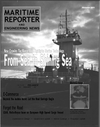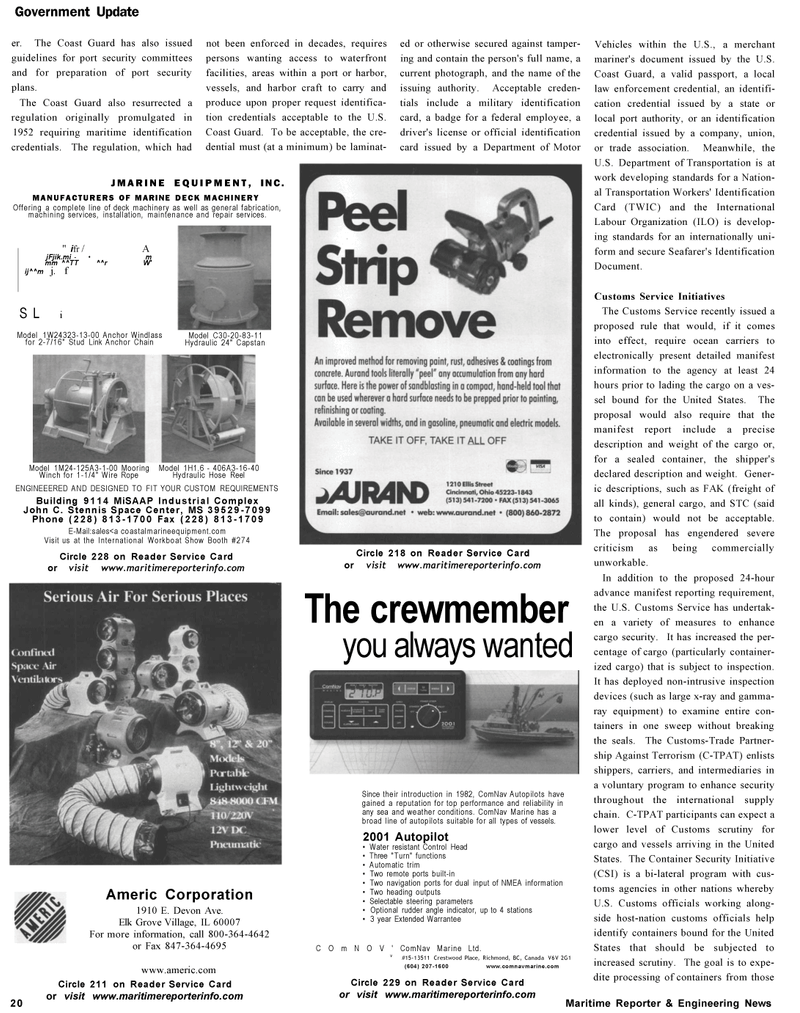Visit us at the International Workboat Show Booth #274
Circle 228 on Reader Service Card
or visit www.maritimereporterinfo.com
Americ Corporation
1910 E. Devon Ave.
Elk Grove Village, IL 60007
For more information, call 800-364-4642
or Fax 847-364-4695
www.americ.com
Circle 218 on Reader Service Card
or visit www.maritimereporterinfo.com
The crewmember
you always wanted
Since their introduction in 1982, ComNav Autopilots have
gained a reputation for top performance and reliability in
any sea and weather conditions. ComNav Marine has a
broad line of autopilots suitable for all types of vessels.
2001 Autopilot
• Water resistant Control Head
• Three "Turn" functions
• Automatic trim
• Two remote ports built-in
• Two navigation ports for dual input of NMEA information
• Two heading outputs
• Selectable steering parameters
• Optional rudder angle indicator, up to 4 stations
• 3 year Extended Warrantee
COmNOV' ComNav Marine Ltd.
V #15-13511 Crestwood Place, Richmond, BC, Canada V6V 2G1
(604) 207-1600 www.comnavmarine.com
20
Circle 211 on Reader Service Card
or visit www.maritimereporterinfo.com
Circle 229 on Reader Service Card
or visit www.maritimereporterinfo.com
Vehicles within the U.S., a merchant
mariner's document issued by the U.S.
Coast Guard, a valid passport, a local
law enforcement credential, an identifi-
cation credential issued by a state or
local port authority, or an identification
credential issued by a company, union,
or trade association. Meanwhile, the
U.S. Department of Transportation is at
work developing standards for a Nation-
al Transportation Workers' Identification
Card (TWIC) and the International
Labour Organization (ILO) is develop-
ing standards for an internationally uni-
form and secure Seafarer's Identification
Document.
Customs Service Initiatives
The Customs Service recently issued a
proposed rule that would, if it comes
into effect, require ocean carriers to
electronically present detailed manifest
information to the agency at least 24
hours prior to lading the cargo on a ves-
sel bound for the United States. The
proposal would also require that the
manifest report include a precise
description and weight of the cargo or,
for a sealed container, the shipper's
declared description and weight. Gener-
ic descriptions, such as FAK (freight of
all kinds), general cargo, and STC (said
to contain) would not be acceptable.
The proposal has engendered severe
criticism as being commercially
unworkable.
In addition to the proposed 24-hour
advance manifest reporting requirement,
the U.S. Customs Service has undertak-
en a variety of measures to enhance
cargo security. It has increased the per-
centage of cargo (particularly container-
ized cargo) that is subject to inspection.
It has deployed non-intrusive inspection
devices (such as large x-ray and gamma-
ray equipment) to examine entire con-
tainers in one sweep without breaking
the seals. The Customs-Trade Partner-
ship Against Terrorism (C-TPAT) enlists
shippers, carriers, and intermediaries in
a voluntary program to enhance security
throughout the international supply
chain. C-TPAT participants can expect a
lower level of Customs scrutiny for
cargo and vessels arriving in the United
States. The Container Security Initiative
(CSI) is a bi-lateral program with cus-
toms agencies in other nations whereby
U.S. Customs officials working along-
side host-nation customs officials help
identify containers bound for the United
States that should be subjected to
increased scrutiny. The goal is to expe-
dite processing of containers from those
Maritime Reporter & Engineering News


 19
19

 21
21
